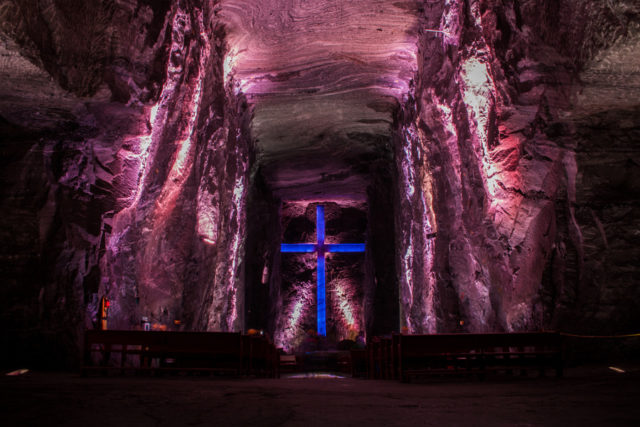
Religious art and architecture at their best aim at the transcendental. But there are a few structures out there in the world that can quite compare to Colombia‘s Catedral de Sal, in the city of Zipaquirá, situated on a plain less than an hour from capital Bogotá.
Part of the Greater Bogotá Metropolitan Area, this charming city of nearly 125,000 dates back to 1600 and still preserves a picturesque colonial core that alone would be worth the drive from Bogotá.
But its main attraction – and one considered the number-one wonder of Colombia – is a giant hole in the ground. Reaching as deep as 180 metres (590 feet) down, to be precise. Accessible via tunnel from the surface, this onetime salt mine (dating back to the pre-Columbian Muisca peoples and gradually expanded beginning in the Spanish colonial and republican periods) housed a miners’ prayer sanctuary that was expanded into a full-blown church in the early 1930s. When that had to be closed because of safety issues, additional tunnels were expanded in the mid 1990s to create a new church (which is not technically a “cathedral” because it has no bishop) that in addition to holding worship services also attracts more than 50,000 sightseers per month.
So as you might imagine, this church is unlike most any other you’ve ever seen – not just the rough rock walls and salt deposits but the lighting, which has more in common with a disco than a house of worship. The mineral smell and humidity complete the unusual sensory effect.
You can take a two-hour guided tour or visit independently. Either way, the pièce de résistance is a via crucis (stations of the cross) nearly 400 m (1,312 ft) long, its 14 stations carved from salt. At the end you emerge into an expansive worship space with an altar and three naves (respresenting life, death, and Jesus Christ‘s resurrection). And the Salt Cathedral is a record-breaker in several ways – including the world’s largest crucifix, 16 m (52 ft) tall by ten (33 ft) wide.
There are other aspects to the former mine worth seeing, as well, such as the Paseo del Minero (Miners’ Way), which illustrates the difficult conditions the mineworkers faced day in and day out. Out on the surface, too, there’s more to see in the Parque de la Sal (Salt Park), with some fascinating minerological displays.

